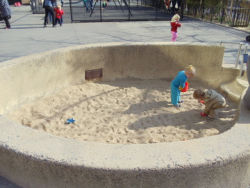MacArthur Playground
MacArthur Playground
In a career that spanned four wars and five decades, General Douglas MacArthur (1880-1964) established himself as an important, if controversial, figure in American history. MacArthur was born on January 26, 1880, in Little Rock Barracks, Arkansas, to General Arthur MacArthur, Jr. (1845-1912), a Civil War hero, and Mary Hardy MacArthur (1852-1935). In 1903, MacArthur graduated first in his class from the United States Military Academy at West Point.
His first tour of duty as a Second Lieutenant was in the Philippine Islands. After serving in Mexico in 1916-1917, and in France during the World War I (1914-1918), MacArthur returned to the Philippines twice in the 1920s. In 1930, President Herbert Hoover (1874-1964) appointed MacArthur Chief of Staff of the Army. Following his retirement in 1935, MacArthur became a field marshal in the Philippine Army, serving until 1941.
Following America’s entry into the World War II (1939-1945) in 1941, the United States Army called MacArthur back into service. In April 1942, President Franklin Delano Roosevelt (1882-1945) named MacArthur the Supreme Allied Commander in the Pacific. MacArthur developed an innovative “island-hopping” strategy, which aimed to maximize Allied victories while minimizing the loss of life. On September 2, 1945, MacArthur accepted the Japanese surrender in Tokyo Bay. He became the military governor of occupied Japan (1945-1950), facilitating that nation’s transition from imperial monarchy to democracy.
The Korean War (1950-1953) gave MacArthur his greatest triumph and his greatest humiliation. The North Koreans had pushed the South Korean Army and supporting American forces to the southernmost tip of the Korean peninsula. Appointed Commander-in-Chief of the United Nations forces at the outbreak of the war, MacArthur engineered the Inchon Landing. This risky amphibious attack required traveling through a narrow channel to a beach whose tides would only allow ships six hours of the day. The mission’s success dramatically reversed the tide of the war.
Although MacArthur was publicly lauded for the bravery and ingenuity he demonstrated throughout his career, his aggressive approach in Korea ultimately led to conflicts with policy makers. MacArthur’s advocacy of an invasion of China as well as the use of atomic weapons against Chinese cities led to his dismissal by President Harry S. Truman (1888-1972) in 1951. That year, following his return to the United States, MacArthur again retired from the military and settled in New York City, residing at the Waldorf Towers.
In 1952, MacArthur ran for the Republican Presidential nomination, losing to fellow retired general Dwight D. Eisenhower (1890-1969). Thereafter, he served as an unofficial advisor to Presidents Eisenhower and John F. Kennedy (1917-1963). After his death in 1964, the General lay in state at the Seventh Regiment Armory on Park Avenue at 66th Street and was buried at Norfolk, Virginia.
MacArthur Park is in the Turtle Bay section of Manhattan. Originally, this area was surrounded by a small wetland cove with an abundance of turtles which gave the community its name. MacArthur Park is located on the F.D.R. Drive between 48th and 49th Streets. Alcoa Plaza Associates constructed the park as part of the United Nations Plaza (1947-53). Following its completion, Alcoa ceded the park to the Board of Estimate. The park opened under NYC Parks jurisdiction on February 28, 1966.
The park boasts a flagpole with yardarm, and a variety of amenities, including a public restroom, benches, slides, swings, a spray shower, and chess tables. Numerous trees provide shade for visitors, who enjoy unobstructed views of Queens and the East River.
Check out your park's Vital Signs
Clean & Safe
Green & Resilient
Empowered & Engaged Users
Share your feedback or learn more about how this park is part of a
Vital Park System





